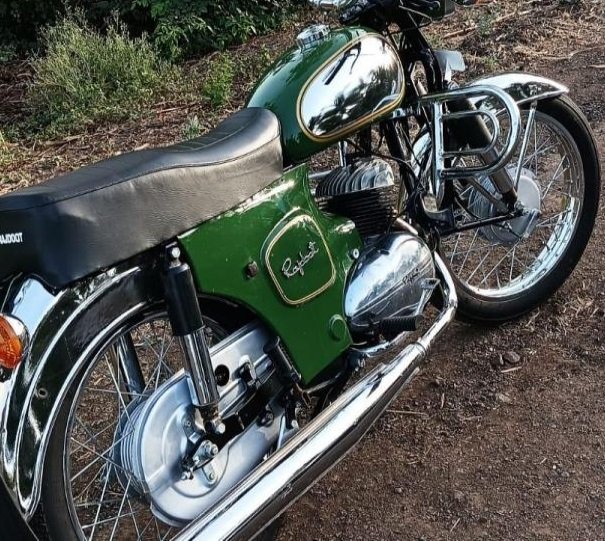The Yamaha Rajdoot 350, often referred to as the “RD 350,” is one of the most iconic motorcycles ever to grace Indian roads. Introduced in the 1980s, this beast was a performance-oriented machine that set new standards in speed, acceleration, and thrill. With its two-stroke parallel-twin engine, classic retro styling, and remarkable power output, the Rajdoot 350 remains a legend in the world of motorcycles. Let’s take a deep dive into its specifications, features, and legacy.
Engine and Performance
Engine Type and Displacement
The Yamaha Rajdoot 350 boasts a two-stroke, parallel-twin, air-cooled engine with a displacement of 347 cc. This engine was known for its high-revving nature and excellent power delivery, making it a dream bike for adrenaline junkies.
Power and Torque
The RD 350 was available in two variants:
- High Torque (HT): Produced 30.5 bhp @ 6750 rpm
- Low Torque (LT): Produced approximately 27 bhp
Despite the slight difference in power, both variants delivered an exhilarating riding experience. The torque figures varied slightly between the HT and LT models, but both versions offered instant throttle response and rapid acceleration.
Fuel System
The Yamaha Rajdoot 350 was equipped with a twin-carburetor system, ensuring smooth and consistent fuel delivery. This setup contributed to the bike’s ability to generate impressive power and torque effortlessly.
Transmission
The Rajdoot 350 came with a 6-speed manual gearbox, allowing riders to exploit the full potential of the engine. The well-spaced gears ensured that the bike could cruise smoothly on highways while also delivering explosive acceleration when needed.
Braking System
- Front Brake: Drum Brake (In Indian Models)
- Rear Brake: Drum Brake
The Indian version of the RD 350 came with drum brakes on both the front and rear wheels, unlike the original international Yamaha RD 350, which had a front disc brake. Although drum brakes were sufficient for regular riding, they struggled to provide the stopping power needed for such a high-performance bike, often leading to braking modifications by enthusiasts.
Wheels and Tyres
- Front Tyre: 3.00 x 18-inch
- Rear Tyre: 3.50 x 18-inch
- Wheel Type: Spoked Wheels
The spoked wheels added to the classic look of the bike while providing durability for various riding conditions. The tyre sizes ensured adequate grip and stability, making the bike suitable for both city and highway rides.
Dimensions and Weight
- Kerb Weight: Approx. 155 kg
- Fuel Tank Capacity: Approx. 16 liters
With a lightweight body and powerful engine, the RD 350 had an excellent power-to-weight ratio, making it one of the fastest bikes of its time. The 16-liter fuel tank provided a decent riding range, though the bike’s fuel consumption was on the higher side due to its two-stroke nature.
Key Features and Design
Classic Retro Styling
The Rajdoot 350 retained the classic retro styling of the original Yamaha RD 350, featuring a round headlamp, a minimalistic fuel tank design, and a long seat. The chrome-finished exhaust pipes and spoked wheels added to its timeless appeal.
2-Stroke Powerhouse
One of the defining characteristics of the RD 350 was its two-stroke engine, which delivered instant power and acceleration. Unlike modern four-stroke engines, the RD 350’s engine produced an unmistakable exhaust note and blue smoke, a signature trait of classic two-stroke motorcycles.
Variants: HT and LT
The RD 350 was launched in two versions:
- HT (High Torque): More powerful, higher performance, but slightly less fuel-efficient.
- LT (Low Torque): Slightly detuned for better fuel economy, but still a powerful machine.
The Legacy of Yamaha Rajdoot 350
The First Performance Bike of India
The Rajdoot 350 was the first proper performance motorcycle to hit the Indian market. During the 1980s and 1990s, it was a dream bike for many riders, offering unmatched power and speed compared to other motorcycles available in India at the time.
Racing and Enthusiast Culture
The RD 350 quickly became popular among street racers and biking enthusiasts due to its raw power and incredible acceleration. Many owners modified their bikes by upgrading brakes, expanding fuel intake, and even increasing the engine displacement to extract even more performance.
The Downfall and Discontinuation
Despite its immense popularity, the Rajdoot 350 faced challenges in the Indian market:
- High Fuel Consumption: The two-stroke engine was fuel-hungry, making it expensive to run compared to four-stroke motorcycles.
- Maintenance Costs: The bike required regular maintenance, and spare parts became difficult to find.
- Government Regulations: Stricter emission norms and increasing demand for fuel-efficient bikes led to its decline.
By the late 1990s, the RD 350 was discontinued in India, marking the end of an era. However, it continues to hold a cult status among vintage bike lovers and collectors.
Restoration and Collector’s Value
Today, finding a well-maintained RD 350 is rare, but those who own one take great pride in preserving and restoring these machines. The bike has gained significant value in the vintage motorcycle market, with some fully restored models selling for a premium price.
Conclusion
The Yamaha Rajdoot 350 remains an unforgettable motorcycle in Indian motorcycling history. With its thrilling performance, classic design, and legendary two-stroke engine, it continues to be a dream machine for enthusiasts. Although it was eventually phased out, the RD 350’s legacy lives on through restored models, biking communities, and the stories of those who had the privilege to ride this beast.
If you ever get the chance to own or ride an RD 350, consider yourself lucky—it’s a piece of history on two wheels.
